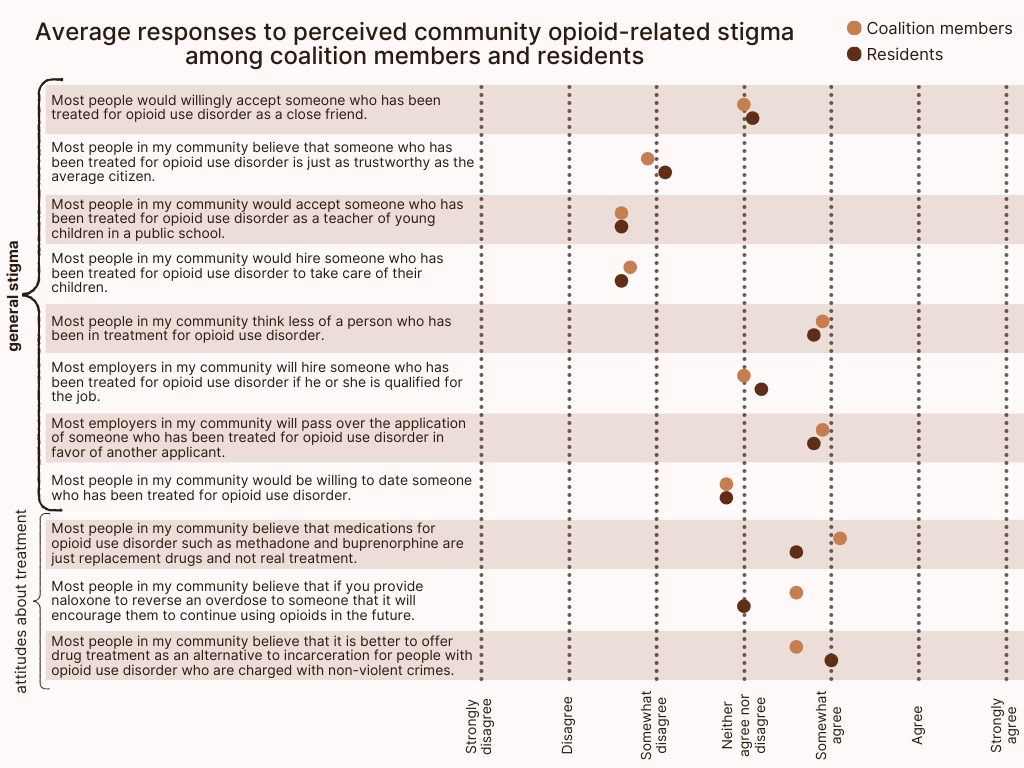Community stigma (stigmatizing beliefs and attitudes that exist in the community) can be a barrier to treatment and recovery for people with substance use disorders. Examples of stigma include not believing that substance use disorder is a medical condition, seeing substance use disorder as a personal choice, and viewing those with substance use disorder as more dangerous. Perceived community stigma is associated with poorer outcomes related to healthcare utilization and healthcare delivery. This week, STASH reviews a study by Daniel M. Walker and colleagues that examined how community members involved in the opioid response differ from the general public in terms of perceived community opioid-related stigma.
What was the research question?
How does perceived community opioid-related stigma differ between substance use coalition members and other community residents?
What did the researchers do?
Over 800 coalition members and 1,100 residents completed surveys about their perceptions of community stigma towards people with opioid use disorder. They indicated their level of agreement with eight statements about general perceived stigma and three statements about attitudes toward treatment (see Figure). The researchers then compared responses between the two groups of respondents.
What did they find?
On average, coalition members and residents responded similarly to the general stigma statements (see Figure). Both groups tended to disagree with statements of acceptance (e.g., “Most people in my community would accept someone who has been treated for opioid use disorder as a teacher of young children in a public school”) and agree with stigmatizing statements (e.g., “Most people in my community think less of a person who has been in treatment for opioid disorder”). However, compared to residents, coalition members perceived greater community stigma towards medication for opioid use disorder, naloxone (Narcan), and drug treatment as an alternative to incarceration, with coalition members sensing more stigmatizing attitudes within the community.

Figure. Average responses to perceived community opioid-related stigma among coalition members and residents. All three “attitudes about treatment” differences were statistically significant. Click image to enlarge.
Why do these findings matter?
Coalition members and residents both perceived opioid-related stigma in their community. Contact interventions can help combat stigma through sharing the lived experiences of people with opioid use disorder with the broader community. Coalition members also reported higher levels of perceived community stigma towards opioid use disorder medications and treatment, which may be associated with burnout or compassion fatigue. Those involved in the opioid response may benefit from learning strategies to reduce compassion fatigue.
Every study has limitations. What are the limitations in this study?
The researchers recruited participants via social media, so the findings cannot be generalized to those in the community who do not have internet access or social media accounts. In addition, the survey only asked about perceived community stigma. Thus, we cannot determine the actual levels of individual or community stigma from this study.
For more information:
To learn more about ways to reduce substance use-related stigma, check out SAMHSA’s “Overcoming Stigma, Ending Discrimination” resource guide. If you are worried that you or someone you know is experiencing addiction, the SAMHSA National Helpline is a free treatment and information service available 24/7. For more details about addiction, visit our Addiction Resources page.
— Caitlyn Matykiewicz, MPH
What do you think? Please use the comment link below to provide feedback on this article.




